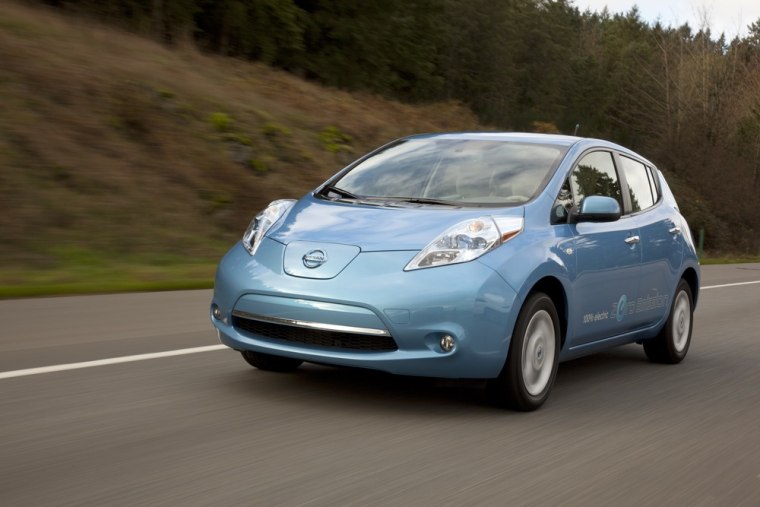"Your mileage may vary" ... That old phrase is even more relevant for the newfangled Nissan Leaf electric vehicle, which has an advertised range of 100 miles on a charge. In fact, the mileage depends quite a bit on your driving style, and the numbers can go up and down in the course of a drive.
Yes, it's possible to get 100 miles or more from the Leaf. But if you're the kind of guy who keeps the car on the road even if the needle is near the "E" mark, you might have to change your ways.
The "needle" on the Leaf isn't a physical needle, but a readout that appears right in front of the driver on the dashboard, as well as on the energy-monitoring displays you can bring up on the center console's touchscreen. You can even bring up a map with two concentric circles, estimating how far you can go in normal mode (in which the Leaf acts pretty much like a normal car) and in eco-mode (which tweaks the car's response to optimize the power savings).
To arrive at those estimates, the Leaf's electronic brain factors in how you've been driving the car up to that point, as well as the load that's being put on the electric motor at that moment. When you're coasting downhill, you can actually add to your range.
Luxury in a Leaf
Let's take my drive through Western Washington's Issaquah Alps as an example. The first seven miles were so effortless that the range went up from 96 to 103 miles in eco-mode. But that was the day's high mark: As multimedia editor Jim Seida and I drove up through the mountains, the numbers were driven down. At the 19-mile mark, when we passed by Snoqualmie Falls (where the TV show "Twin Peaks" was filmed), the Leaf's screens told us we had only 45 miles of driving left.
Those numbers quickly crept up again during our descent from the mountains — back to a range of 60 miles. But we lived a little too luxuriously on the way back: Turning on the heater and the fan ate into our electrical reserve, and by the time we returned to Redmond, we had an estimated 24 miles left in the batteries. A 47-mile trip took away 72 miles of my original estimated range. Good thing we didn't go all the way to Snoqualmie Pass (which would have been a 100-mile round trip).
If we were true hypermilers, we would have been able to get by with less electricity — but instead, we drove the Leaf like a normal car. The bottom line is that Leaf drivers will have to think about their driving strategy: If a visit to the neighborhood grocery store is your only stop of the day, there's nothing to worry about. If you have a 25-mile commute to work, and you have to stop back at home before going out to an evening engagement that's 5 miles away, you just might be thinking about charging up while you're at work and using the eco-mode setting.
Guilty as charged?
Speaking of charged up, I received some sharp comments about the fact that I topped off the Leaf's batteries on Monday by plugging into an outlet at the office parking garage.
"The main problem is you are stealing someone else's electricity," one commenter wrote.
Another writer was critical of the whole electric-vehicle concept: "When that big 4x4 is blocking you in, it will be me. The hand waving you forward will have an extended middle finger. Just for you EV elites."
Such responses show that the move toward "electrification" of the automotive industry could run into a few culture clashes along the way. What principles will find their way into electric-car etiquette, or corporate and governmental policies?
I'd like to think that places like the Oregon city of Hillsboro (where Intel is the largest employer) are leading the way in the creation of charging-station havens. I'd like to think that the EV Project, which is due to install 15,000 charging stations over the next year with $115 million in support from the U.S. Department of Energy, is on the right track. But for some people, having taxpayers foot the bill for the installation of charging stations would be going too far.
The way I see it, the success of the Leaf will depend on the spread of those charging stations — not so much because they're necessary, but because that will reassure folks like me that there's a backup plan just in case the Leaf sometimes doesn't go as far as you expect it to.
You can try the Leaf out for yourself during the "Drive Electric Tour," sponsored by Nissan. The next stop is in San Francisco. Keep checking our Green Innovation section for more about electric cars and our "Electric Road Trip."
Connect with the Cosmic Log community by "liking" the log's Facebook page or following . You can also check out my book about the controversial dwarf planet and the search for new worlds.
